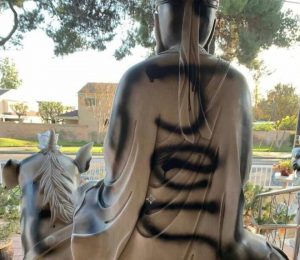The Mongolian Kanjur (the translated words of the Buddha) is the first part of the Mongolian Buddhist Canon translated from Tibetan into the classical Mongolian language, and consists of 108 volumes. Its translation began in the 14th century until, in the 17th century under the rule of Ligdan Khan (1588–1634), the khagan* of the Northern Yuan dynasty, the translation of the entire Kanjur was completed. This version of the Mongolian Kanjur became the basis for a 108-volume edition made from printed boards in 1717–20, under the Kangxi Emperor (1654–1722), the third emperor of the Qing dynasty.
The Mongolian Kanjur is a source of cultural identity for Mongolia and copies are stored in every monastery in the country. During the socialist period, xylographs were consigned to flames and monasteries were left bereft of their sacred scriptures. During 1956–58, the Indian linguist, scholar, and prominent politician Prof. Raghu Vira (1902–63) obtained a microfilm copy of the rare Kanjur manuscripts during his travels to Mongolia and brought them to India, where he initiated their reprinting. This task was destined to be completed by his son, Prof. Lokesh Chandra. In 1973, the Mongolian Kanjur was republished and distributed to libraries around the world. Several copies were also donated to Russian Buddhists in Buryatia, Kalmykia, and Zabaikalye.

India’s Ministry of Tourism and Culture took up the project of reprinting all 108 volumes of Mongolian Kanjur under the National Mission for Manuscripts, a project established by the ministry in February 2003. The project is intended to unearth and preserve India’s vast wealth of ancient manuscripts. Work on the Kanjur is being carried out under the supervision of Prof. Lokesh Chandra. Volumes of the sacred canon are intended to be distributed to monasteries in Mongolia and Russia as a symbol of cultural dialogue and as a means to strengthen diplomatic relations. The first set of five volumes of the Mongolian Kanjur was presented to the president of India, Ram Nath Kovind, on 4 July 2020 on the occasion of Dhamma Chakra Pravartana (The First Turning of the Wheel of Dharma), a day observed also as Guru Purnima by Buddhists and Hindus alike—a day to mark reverence to their gurus.**
Indian prime minister Narendra Modi also gave a special address by video for the occasion. A set of volumes was then handed over to Gonching Ganbold, the ambassador of Mongolia to India, by the union minister of state for culture and tourism, Prahlad Singh Patel, in the presence of the minister of state for minority affairs, Kiren Rijiju.
The first set of 50 volumes was presented on 26 May 2021, during the Buddha Purnima celebration organized by India’s Ministry of Culture. The program included an online keynote address from Modi to the government of Mongolia.


The Mongolian Kanjur published by India’s Ministry of Culture was presented in Russia during a visit by an official Indian delegation in September 2021. The visit was aimed at establishing collaboration with Buddhist organizations and educational and cultural institutions. The delegation included members from the Indira Gandhi National Center for the Arts, the International Center for Cultural Studies, the International Buddhist Confederation, and the Asian Buddhist Conference for Peace. The delegates visited Moscow, St. Petersburg, Chita, Buryatia, Kalmykia, and Tuva.*** On 17 September, the delegates met the head of Datsan Gunzechoinei in St. Petersburg, Buda Balzhievich Badmaev (Lama Jampa Donyed), and offered him the first copy of the sacred canon.
On 21 September 2021, the Indian delegation visited the central khurul (monastery) of Kalmykia, the Golden Abode of Shakyamuni Buddha, where they presented the first volume of the Mongolian Kanjur and offered to the khurul consecrated water from the Ganges River and a statue of Green Tara. The honorary representative of His Holiness the Dalai Lama to Russia, Mongolia, and the members of the Commonwealth of Independent States, and shadjin lama (head lama) of the Kalmyk people, Telo Tulku Rinpoche, hosted the delegation and discussed further cooperation. As a result of this cooperation, all the 108 volumes of the Mongolian Kanjur were sent by India’s Ministry of Culture to the central khurul,which arrived at the library of the Kalmyk monastery on 15 May.

On 18 May, the volumes of the Mongolian Kanjur were delivered to Aginsky Datsan Dechen Lhundubling (Abode of the Spontaneous Realization of Great Bliss), one of the leading centers of Buddhist education in Russia, in Agin-Buryat District of Transbaikal Territory (Zabaykalye), in southeastern Siberia. A prayer ceremony was held there, along with a mandala offering, followed by a talk by the Did Khambo Lama of the Trans-Baikal Territory, Tsyren Lama Dondukbaev, who spoke about the history of the emergence and spread of the sacred Kanjur. Aginksy Datsan also received the first volume of the canon in the autumn of 2021, when the Indian delegation visited the monastery.

* Khagan is an imperial rank and title in the Turkic, Mongolic, and other languages, equal to the status of emperor and one who rules a khaganate (empire).
** Reliease Mangolian kanjur Manuscripts (YouTube)
*** Indian Delegation Visits Russia to Establish Collaboration with Buddhist Organizations (BDG)
See more
First five re-printed volumes of Mongolian Kanjur Manuscripts released (Press Information Bureau, Government of India)
Для дальнейшего развития Дхармы (Khurul.ru)
Ганжуур –подарок из Индии (Агинский дацан)















